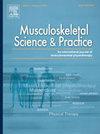Barriers and facilitators to exercise-based rehabilitation in people with musculoskeletal conditions: A systematic review
IF 2.2
3区 医学
Q1 REHABILITATION
引用次数: 0
Abstract
Background
Exercise-based rehabilitation is the first line of treatment for people with musculoskeletal conditions. However, uptake and adherence are suboptimal, compromising the success of rehabilitation.
Objectives
To identify the barriers and facilitators that influence adherence to exercise-based rehabilitation in people with musculoskeletal conditions. Additionally, to identify the methods and instruments used to determine these barriers and facilitators.
Design
Systematic review
Methods
Five databases from inception to May 2024 using terms related to exercise, musculoskeletal conditions, methods, barriers and facilitators. Risk of bias was assessed using either the Newcastle-Ottawa Scale or Cochrane risk of bias tool. Using an inductive thematic approach, barriers and facilitators were grouped into intrapersonal, interpersonal and community factors. Methods/instruments were categorized into three groups, being questionnaires, interviews and focus-groups.
Results
Eighty-one of 8380 studies were included. The majority of studies were of good or fair quality (95%). The most frequently identified barriers were lack of time (53%), pain (45%) and health (40%). The most frequent facilitators were self-efficacy (42%), perceived health benefits (32%) and previous experiences (30%). The methods used were interviews (n = 53), questionnaires (n = 44) and focus groups (n = 10).
Conclusion
Most barriers and facilitators to exercise were related to intrapersonal factors. Although there is a lack of consistency in instruments used, the reported barriers and facilitators were similar across studies. Clinicians and researchers should consider intrapersonal factors when promoting exercise-based rehabilitation programs. Applying a theoretical framework to investigate barriers and facilitators to exercise-based rehabilitation in people with musculoskeletal conditions might assist practitioners to prioritize their practice.
肌肉骨骼疾病患者运动康复的障碍和促进因素:系统综述
背景:以运动为基础的康复是肌肉骨骼疾病患者的一线治疗方法。然而,吸收和坚持是次优的,影响康复的成功。目的确定影响肌肉骨骼疾病患者坚持运动康复的障碍和促进因素。此外,确定用于确定这些障碍和促进因素的方法和工具。系统回顾方法5个数据库,从建立到2024年5月,使用与运动、肌肉骨骼状况、方法、障碍和促进因素相关的术语。使用纽卡斯尔-渥太华量表或Cochrane偏倚风险工具评估偏倚风险。采用归纳主题方法,将障碍和促进因素分为个人因素、人际因素和社区因素。方法/手段分为问卷调查、访谈和焦点小组三大类。结果8380项研究纳入81项。大多数研究质量良好或一般(95%)。最常见的障碍是缺乏时间(53%)、疼痛(45%)和健康(40%)。最常见的促进因素是自我效能感(42%)、感知健康益处(32%)和以前的经历(30%)。采用访谈法(n = 53)、问卷法(n = 44)和焦点小组法(n = 10)。结论运动障碍和促进因素多与个人因素有关。尽管所使用的工具缺乏一致性,但报告的障碍和促进因素在所有研究中都是相似的。临床医生和研究人员在推广以运动为基础的康复方案时应考虑个人因素。应用理论框架来研究肌肉骨骼疾病患者基于运动的康复障碍和促进因素可能有助于从业者优先考虑他们的实践。
本文章由计算机程序翻译,如有差异,请以英文原文为准。
求助全文
约1分钟内获得全文
求助全文
来源期刊

Musculoskeletal Science and Practice
Health Professions-Physical Therapy, Sports Therapy and Rehabilitation
CiteScore
4.10
自引率
8.70%
发文量
152
审稿时长
48 days
期刊介绍:
Musculoskeletal Science & Practice, international journal of musculoskeletal physiotherapy, is a peer-reviewed international journal (previously Manual Therapy), publishing high quality original research, review and Masterclass articles that contribute to improving the clinical understanding of appropriate care processes for musculoskeletal disorders. The journal publishes articles that influence or add to the body of evidence on diagnostic and therapeutic processes, patient centered care, guidelines for musculoskeletal therapeutics and theoretical models that support developments in assessment, diagnosis, clinical reasoning and interventions.
 求助内容:
求助内容: 应助结果提醒方式:
应助结果提醒方式:


